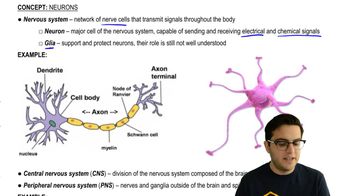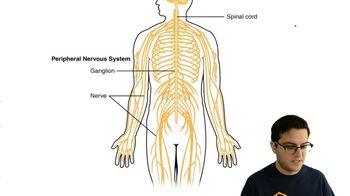Table of contents
- 1. Introduction to Biology2h 42m
- 2. Chemistry3h 40m
- 3. Water1h 26m
- 4. Biomolecules2h 23m
- 5. Cell Components2h 26m
- 6. The Membrane2h 31m
- 7. Energy and Metabolism2h 0m
- 8. Respiration2h 40m
- 9. Photosynthesis2h 49m
- 10. Cell Signaling59m
- 11. Cell Division2h 47m
- 12. Meiosis2h 0m
- 13. Mendelian Genetics4h 44m
- Introduction to Mendel's Experiments7m
- Genotype vs. Phenotype17m
- Punnett Squares13m
- Mendel's Experiments26m
- Mendel's Laws18m
- Monohybrid Crosses19m
- Test Crosses14m
- Dihybrid Crosses20m
- Punnett Square Probability26m
- Incomplete Dominance vs. Codominance20m
- Epistasis7m
- Non-Mendelian Genetics12m
- Pedigrees6m
- Autosomal Inheritance21m
- Sex-Linked Inheritance43m
- X-Inactivation9m
- 14. DNA Synthesis2h 27m
- 15. Gene Expression3h 20m
- 16. Regulation of Expression3h 31m
- Introduction to Regulation of Gene Expression13m
- Prokaryotic Gene Regulation via Operons27m
- The Lac Operon21m
- Glucose's Impact on Lac Operon25m
- The Trp Operon20m
- Review of the Lac Operon & Trp Operon11m
- Introduction to Eukaryotic Gene Regulation9m
- Eukaryotic Chromatin Modifications16m
- Eukaryotic Transcriptional Control22m
- Eukaryotic Post-Transcriptional Regulation28m
- Eukaryotic Post-Translational Regulation13m
- 17. Viruses37m
- 18. Biotechnology2h 58m
- 19. Genomics17m
- 20. Development1h 5m
- 21. Evolution3h 1m
- 22. Evolution of Populations3h 52m
- 23. Speciation1h 37m
- 24. History of Life on Earth2h 6m
- 25. Phylogeny2h 31m
- 26. Prokaryotes4h 59m
- 27. Protists1h 12m
- 28. Plants1h 22m
- 29. Fungi36m
- 30. Overview of Animals34m
- 31. Invertebrates1h 2m
- 32. Vertebrates50m
- 33. Plant Anatomy1h 3m
- 34. Vascular Plant Transport1h 2m
- 35. Soil37m
- 36. Plant Reproduction47m
- 37. Plant Sensation and Response1h 9m
- 38. Animal Form and Function1h 19m
- 39. Digestive System1h 10m
- 40. Circulatory System1h 57m
- 41. Immune System1h 12m
- 42. Osmoregulation and Excretion50m
- 43. Endocrine System1h 4m
- 44. Animal Reproduction1h 2m
- 45. Nervous System1h 55m
- 46. Sensory Systems46m
- 47. Muscle Systems23m
- 48. Ecology3h 11m
- Introduction to Ecology20m
- Biogeography14m
- Earth's Climate Patterns50m
- Introduction to Terrestrial Biomes10m
- Terrestrial Biomes: Near Equator13m
- Terrestrial Biomes: Temperate Regions10m
- Terrestrial Biomes: Northern Regions15m
- Introduction to Aquatic Biomes27m
- Freshwater Aquatic Biomes14m
- Marine Aquatic Biomes13m
- 49. Animal Behavior28m
- 50. Population Ecology3h 41m
- Introduction to Population Ecology28m
- Population Sampling Methods23m
- Life History12m
- Population Demography17m
- Factors Limiting Population Growth14m
- Introduction to Population Growth Models22m
- Linear Population Growth6m
- Exponential Population Growth29m
- Logistic Population Growth32m
- r/K Selection10m
- The Human Population22m
- 51. Community Ecology2h 46m
- Introduction to Community Ecology2m
- Introduction to Community Interactions9m
- Community Interactions: Competition (-/-)38m
- Community Interactions: Exploitation (+/-)23m
- Community Interactions: Mutualism (+/+) & Commensalism (+/0)9m
- Community Structure35m
- Community Dynamics26m
- Geographic Impact on Communities21m
- 52. Ecosystems2h 36m
- 53. Conservation Biology24m
45. Nervous System
Neurons and Action Potentials
Problem 15e`
Textbook Question
Certain species of frogs in the genus Phyllobates have a powerful defensive adaptation—their skin can secrete a milky fluid that contains an extremely toxic compound called batrachotoxin (BTX). These frogs, which are found in Colombia, are known as poison dart frogs because some indigenous Colombian hunters coat the tips of their blowgun darts with the frogs' skin secretions. An animal hit by one of these darts dies quickly.
What is the mechanism of action of BTX?
Predict the effects of each of the following on the membrane potential of a neuron simultaneously poisoned with BTX:
(a) Removing extracellular sodium ions;
(b) Increasing the intracellular potassium ion concentration;
(c) Adding tetrodotoxin from puffer fish.
 Verified step by step guidance
Verified step by step guidance1
Batrachotoxin (BTX) is a potent toxin that affects the nervous system by binding to voltage-gated sodium channels in neurons. This binding keeps the sodium channels open, preventing them from closing, which leads to a continuous influx of sodium ions into the neuron.
To predict the effects of removing extracellular sodium ions on a neuron poisoned with BTX, consider that BTX keeps sodium channels open. If extracellular sodium ions are removed, the gradient driving sodium into the cell is reduced, potentially decreasing the depolarization effect caused by BTX.
Increasing the intracellular potassium ion concentration affects the membrane potential by altering the potassium gradient. Normally, potassium ions flow out of the neuron, contributing to repolarization. Increasing intracellular potassium reduces this gradient, potentially making repolarization less effective and maintaining a depolarized state.
Tetrodotoxin (TTX) from puffer fish is known to block voltage-gated sodium channels. If TTX is added to a neuron poisoned with BTX, it could counteract BTX's effect by preventing sodium channels from opening, thus reducing sodium influx and potentially restoring normal membrane potential.
Consider the combined effects of these manipulations on the membrane potential: removing extracellular sodium ions reduces depolarization, increasing intracellular potassium affects repolarization, and adding TTX blocks sodium channels. Together, these actions could counteract the continuous depolarization caused by BTX, potentially stabilizing the membrane potential.
 Verified video answer for a similar problem:
Verified video answer for a similar problem:This video solution was recommended by our tutors as helpful for the problem above
Video duration:
1mPlay a video:
Was this helpful?
Key Concepts
Here are the essential concepts you must grasp in order to answer the question correctly.
Batrachotoxin Mechanism of Action
Batrachotoxin (BTX) is a potent neurotoxin that affects the function of voltage-gated sodium channels in neurons. It binds to these channels, forcing them to remain open, which disrupts the normal flow of sodium ions into the cell. This leads to a continuous depolarization of the neuron, preventing it from returning to its resting state and causing paralysis or death due to uncontrolled nerve signaling.
Recommended video:
Guided course
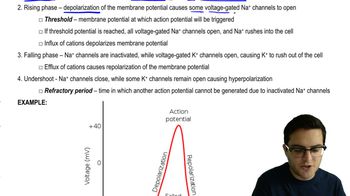
Action Potential
Membrane Potential
Membrane potential refers to the electrical potential difference across a cell's plasma membrane, primarily influenced by the distribution of ions like sodium, potassium, and chloride. In neurons, the membrane potential is crucial for the generation and propagation of action potentials. Changes in ion concentrations inside or outside the cell can significantly alter the membrane potential, affecting neuronal excitability and signaling.
Recommended video:
Guided course
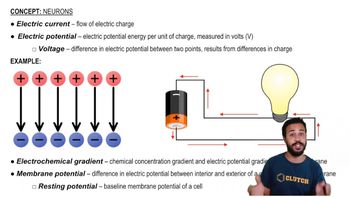
Membrane Potential
Tetrodotoxin and Ion Channel Blockage
Tetrodotoxin (TTX) is another neurotoxin that specifically blocks voltage-gated sodium channels, preventing sodium ions from entering the neuron. This blockage inhibits action potential generation, leading to a loss of nerve signal transmission. When applied to a neuron poisoned with BTX, TTX can counteract BTX's effects by preventing the continuous influx of sodium ions, potentially stabilizing the membrane potential and reducing toxicity.
Recommended video:
Guided course
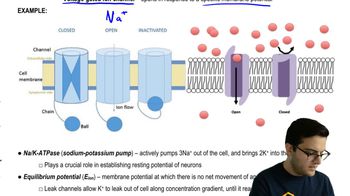
Ion Channels and Pumps
Related Videos
Related Practice



